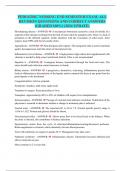PEDIATRIC NURSING END SEMESTER EXAM- ALL
REVISION QUESTIONS AND CORRECT ANSWERS
(GRADED 100%) (2024 UPDATE)
Hirschsprung disease - ANSWER- A mechanical obstruction caused by a lack of motility of a
segment of the intestine resulting from the lack of innervation by ganglion cells. There is a lack of
peristalsis in the affected segment, which interferes with the evacuation of solid waste. After
surgery, keep NPO until bowel sounds return.
Appendicitis - ANSWER- Pain dissipates after rupture. The nasogastric tube is used to maintain
gastric decompression until the return of intestinal activity.
Inflammatory bowel disease - ANSWER- A high-protein, high-calorie diet supplemented with
vitamins is needed to help correct nutritional deficits. Fiber is not recommended.
Hepatitis A - ANSWER- Contagious disease, transmitted through the fecal-oral route. The
nurse should teach infection control measures to family.
Biliary atresia - ANSWER- A progressive, destructive, sclerosing, inflammatory process that
leads to obliteration or discontinuity of the hepatic and/or common bile ducts at any point from the
porta hepatis to the duodenum
Congenital defect: fetal or perinatal
Symptoms: Jaundice, dark urine, light stools
Treatment is surgery: Kasai procedure or liver
Transplant. Approximately 80% to 90% of children will require liver transplantation.
Intussusception - ANSWER- Passage of a normal stool indicates resolution. Notification of the
physician is essential to determine whether a change in treatment plan is indicated.
Normal urine - ANSWER- The expected pH. is 4.8 to 7.8. Normal specific gravity range is
1.016 to 1.022. Protein and glucose should be absent.
Vesicoureteral reflux - ANSWER- Allows urine flow to be forced back to the kidneys. When
the urine is infected, this contributes to kidney infections.
Hypertension results from the cycle of infection/inflammation/scarring/decreased perfusion.
Renin-angiotensin is released, which ultimately elevates blood pressure.
Treat with antibiotics or surgery in grades IV-V. Management may take years.
Nephrotic syndrome - ANSWER- Inflammatory disease: Glomerulus becomes inflamed and
allows molecules to pass
Most common in 2–6-year-olds
,Characterized by: Proteinuria (frothy urine), Hypoalbuminemia, Edema
Hypoalbuminemia is a result of the large amounts of protein that leak through the glomerular
membrane into the urine. Measuring weight at the same time each day is the most accurate way to
determine fluid gains and losses. The child will have a variable level of tolerance for activity. This
will also be affected by the labile moods associated with steroid administration. The nurse should
assist the family in adjusting activities for the child.
Tx: Prednisone, diuretics, albumin, low salt diet, ensure position changes, monitor for fever, cough,
and abdominal pain.
Acute glomerulonephritis - ANSWER- Immune reaction to group A beta-hemolytic
Streptococcal infection. Most common in young children 5-12 yrs. 1-2 weeks after strep throat, 3-
6 weeks after skin infection.
Characterized by: Sudden onset, Hematuria, Proteinuria, edema, Renal insufficiency, Hematuria:
tea- or cola-colored urine, Hypertension, periorbital edema
Acute hypertension is anticipated and requires frequent monitoring for early intervention.
Tx: Antihypertensives, low salt, diuretics
Myelomeningocele - ANSWER- Neural tube defect that contains meninges, spinal fluid, and
nerves. With diet modification and regular toilet habits to prevent constipation and impaction,
some degree of fecal continence can be achieved. Assessment of the fontanels and daily
measurements of head circumference will aid in early detection of postoperative hydrocephalus.
Neurogenic bladder - ANSWER- a urinary problem caused by interference with the normal
nerve pathways associated with urination
Self-straight catheterization can be done at age 6.
Apnea of infancy - ANSWER- cessation of breath for longer than 20 seconds in infant. Parents
should be taught CPR.
Group A beta-hemolytic streptococci - ANSWER- risk for acute rheumatic fever and acute
glomerulonephritis.
Rheumatic fever - ANSWER- Caused by untreated group A beta-hemolytic strep
Manifests 2-6 weeks after infection Immune response causes inflammation in heart, brain, skin &
Joints
Can cause permanent damage to heart valves
Clinical manifestations
• Arthritis • Carditis • Chorea • Erythema marginatum • Subcutaneous nodules
, Therapeutic management
• Penicillin is the drug of choice; erythromycin
Ethylsuccinate in penicillin-allergic children
• Aspirin or corticosteroids are administered to speed
Resolution of the inflammatory process
• Antibiotic prophylaxis
Sensorimotor period - ANSWER- In Piaget's theory, the period of cognitive development from
birth to about 2 years in which the child has not yet achieved object permanence. Babies learn
primarily from their senses and their own actions (cause and effect) and display stranger anxiety.
Sense of self is directly related to having needs met. No concept of death.
Preoperational thought - ANSWER- Piaget's second stage of cognitive development, occurring
from ages 2 through 7, as the child learns language, symbolic play, and symbolic drawing, but does
not grasp abstract concepts, such as conservation (big cup vs small cup with same volume). The
child represents ideas through words and images. Children in this phase are egocentric.
Concrete operations - ANSWER- Piaget's stage in which children learn such concepts as
conservation and mathematical transformations; about 7 - 11 years of age
Formal operations - ANSWER- in Piaget's theory, the stage of cognitive development
(normally beginning about age 12) during which people begin to think logically, hypothetically,
and morally about abstract concepts.
Infancy - ANSWER- Birth to 1 year, trust vs mistrust, strength: hope, strong maternal influence
Early childhood - ANSWER- Age 2-3, autonomy vs shame/self doubt, strength: willpower,
parental figures are influential. By age 3, offering choices is very helpful. Stuttering also begins at
age 3. No concept of death but sensitive to others' emotions.
Preschool - ANSWER- Age 4-5, initiative vs guilt, strength: purpose, influence from parents,
family, and friends. Fear that their insides will come out with intrusive procedures. At age 4 the
child exhibits more aggression, but by age 5 becomes more tranquil. Death is impermanent and
deliberately caused.
Middle childhood - ANSWER- Age 6-11, industry vs inferiority, strength: competence,
influenced by school
Adolescence - ANSWER- Age 12-18, identity vs confusion, strength: fidelity, influence from
peers
Young adulthood - ANSWER- Age 18-35, intimacy vs isolation, strength: love, influence:
spouse




